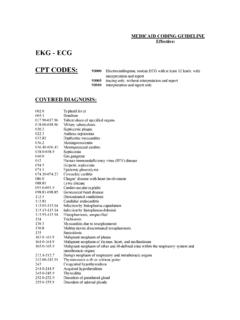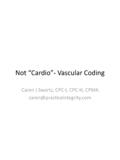Transcription of Use of a Vascular Doppler in Diabetics with PAD
1 Use of a Vascular Doppler in Diabetics with PADDr. Anita Kharbteng,Clinical Support Manager,Asia Pacific, Cardinal HealthGLOBALLEADERSHIPGLOBALLEADERSHIPP eripheral Arterial Disease (PAD) PAD is a condition characterisedby atherosclerotic occlusive disease of the lower extremities. The most common symptom of PAD is intermittent claudication(IC). More extreme presentations of PAD include rest pain, tissue loss, or gangrene; collectively termed Critical Limb Ischaemia (CLI). The symptoms are often subtle and hence physicians need to be proactive in looking for PAD, realisingthat it may often be asymptomatic. GLOBALLEADERSHIPRISK FACTORS MurabitoJM et al. Circulation 1997;96:44 49; LaurilaA et al. ArteriosclerThromVascBiol1997;17:2910 2913;MalinowMR et al.
2 Circulation 1989;79:1180 1188; BrigdenML. PostgradMed 1997;101:249 262. Gender(male) Increasing Age Smoking High blood pressure Diabetes High Cholesterol Family history of heart attack or stroke Fibrinogen HomocysteinaemiaPADA therosclerosisArteriosclerosisAtherothro mbosisIschaemicstrokeMyocardialinfarctio nDiabetes and smoking are the strongest risk factor for of ABI has shown the prevalanceof Diabetes in PAD individuals: 40yrs old is 20% 50yrs old is 29% Peripheral Arterial Disease Detection, Awareness and Treatment in Primary Care Alan T. Hirsch, MD et al. JAMA, 2001;286-1317-1324 GLOBALLEADERSHIPPAD a Walking Time Bomb! Patients with PAD have a higher 5-year mortality rate than breast cancer ~40% of amputees die within 2 years of amputationVascular Disease Foundation and the American Cancer SocietyGLOBALLEADERSHIPPAD in Diabetes Diabetes is the strongest risk factor for PAD PAD in diabetes is different in its biology, clinical presentation, and management.
3 In contrast to the focal and proximal atherosclerotic lesions of PAD in other high risk patients, in Diabetics the lesions are more diffuse and distal - tibialvessels below the knee. PAD in diabetes is usually accompanied by peripheral neuropathy with impaired sensory feedback. Thus they may not present with the classic symptom of IC. They have subtle symptoms like leg fatigue and slow walking velocity and thus they are simply attributed to old age. diabetic pts with PAD experience worse lower-extremity function than non- Diabetics These Pts are more prone to sudden ischemia of arterial thrombosis leading to CLI and risk of amputation. This lends urgency to the task of diagnosing PAD in those apparently asymptomatic individuals with of PAD PAD sufferers have a five-fold risk of death from heart attack or stroke.
4 diabetic patients are at an even higher risk. Approx 27% of patients with PAD show progression of symptoms over a 5-year period with limb loss in ~4%. The majority of patients remain stable in their lower limb symptoms but there is a striking excess in cardiovascular events in the same 5-year period with 20% sustaining nonfatal events (MI and stroke)anda 30% mortality rate. Patients with CLI have worse outcomes: 30% have amputations 20% die within 6 monthsGLOBALLEADERSHIPI mpact of PAD PAD in diabetes also adversely affects quality of life, contributing to long-term disability and functional impairment that is often severe There are significant economic costs of health care, reduced productivity, and personal expenses associated with a chronic manifestation of PAD.
5 Identifying a patient with subclinical disease and instituting preventative measure may possibly avoid acute, limb-threatening iscemia, MI and PADUndi agnose d PADS ymptomatic PAD60%40%Diagnosed PADUndi agnose d PADA symptomatic PAD95%5%PAD is still under-diagnosed!Source: US PAD Market Assessment Study May 2003 Diagnosis of PADGLOBALLEADERSHIPD iagnosis of PAD in Diabetes Medical History and Physical Examination Palpation of peripheral pulses (high degree of false-positive and false-negative) Ankle Brachial Index (ABI): a reproducible, reasonably accurate, noninvasive measurement of PAD and the determination of disease severity. It has been validated against angiogram and found to be 95% sensitive and almost 100% ANKLE-BRACHIAL INDEX (ABI) The ABI is a simple (5 mins) and inexpensive test that can identify patients with PAD The ABI test is a systolic blood pressure comparison between the arms (brachial) and ankles (dorsalispedisand posterior tibial) You only need to use standard blood pressure cuffs and a Nicolet Doppler to listen and look at the blood do an ABI Exam?
6 It is a fast, effective tool for screening for PAD It is non-invasive, easy , and affordable Recommended in patients with : 65+ years old diabetic High blood pressure overweight Inactive or bedridden high cholesterol Family history of heart attack or strokePerforming the ABI ExamUsing your Nicolet Vascular Using your Nicolet Vascular DopplerDopplerGLOBALLEADERSHIPWhat you ll need to perform the ABI Exam Your Nicolet Vascular Doppler with 8 MHz probe Ultrasound gel cm, 10 cm or 12 cm blood pressure cuffs Sphygmomanometer Pen, paper and Nicolet ABI chartTypical ABI ComponentsGLOBALLEADERSHIPWhat You ll Need to Perform the ABI Exam Nicolet VersaLabw/8 MHz probe Ultrasound gel Proper size cuffs Sphygmomanometer Pen.
7 Paper and NicoletABI chartGLOBALLEADERSHIPD oppler WaveformsGLOBALLEADERSHIPC hoose the proper cuff The AHA recommends the cuff bladder size be 20% wider than the limb diameter. Generally, a 10 cm cuff is fine for use at both the ankle and arm sites. Use a 12 cm cuff for patients with larger limbs or a cm cuff for smaller limbs. Be sure to use the same size cuffs on both the arms and the Correct Brachial Pressure Have the patient lie supine for a few minutes prior to test. Place the appropriate size blood pressure cuff about midway up the patient s upper arm above the Brachial PressuresObtaining Brachial Pressures Attach the sphygmomanometer. Place ultrasound gel at the right arm brachial location. Hold the probe as if it were a pen or pencil, angling it so it points up the patient s arm.
8 The angle will be 45-60 degrees for most probes. Slowly move the probe across the brachial area until the pulsating, whooshing sound is Arterial Sounds It is very important to distinguish arterial from venous sounds. Arterial sounds: are synchronized with every heartbeat. have a rhythmic whooshing sound. Make sure that you always use an artery to take blood pressures!GLOBALLEADERSHIPD istinguish Venous Sounds It is very important to distinguish venous from arterial sounds. Venous sounds are significantly different from arterial sounds, they: are spontaneous and vary with respiration. sound like the wind blowing through the trees. Make sure that you always use an artery to take blood pressures!GLOBALLEADERSHIPO btaining Brachial Pressures Once you find an arterial sound, adjust the probe to find the loudest possible signal.
9 Hold this position and signal for the rest of the procedure. Begin inflating the blood pressure cuff. Now is a good time to print a waveform on the Brachial WaveformsSimple Waveform Trace with Spectral smooth, uninterrupted Brachial Pressures Continue inflating, the flow sound will cease as the cuff pressure begins to stop the blood flow. Stop inflating at about 10 - 20 mmHGpast this 8 MHz probeGLOBALLEADERSHIPO btaining Brachial Pressures Slowly deflate the cuff until the sound returns. At the point the sound returns, note the location of the gauge needle. That is the arm s systolic pressure Quickly deflate the blood pressure cuff to 0 mmHg. Elitewith 8 MHz probeGLOBALLEADERSHIPR ecording Pressures Record the pressure on your Nicolet ABI report form shown at the right or on the VersaLabprintout.
10 We recommend attaching the printout to the back of the ABI form. Repeat the procedure for the other Report Form (Catalog #ABI12)GLOBALLEADERSHIPO btaining Ankle Pressures There are two locations suitable for obtaining the ankle pressure:Posterior tibialarteryDorsalispedisarteryGLOBALLEA DERSHIPO btaining Ankle Pressures Most clinicians try to obtain the posterior tibialpressure first. Use the dorsalispedispressure if posterior tibialpressure can t be obtained. If values for both sites are obtained, use the highest value for the the Ankle Cuff Use the appropriate size cuff. Wrap the cuff snugly around the patient s ankle, just above the foot. Attach the sphygmomanometerto the TibialArtery Position the probe tip and gel just behind the ankle bone.






